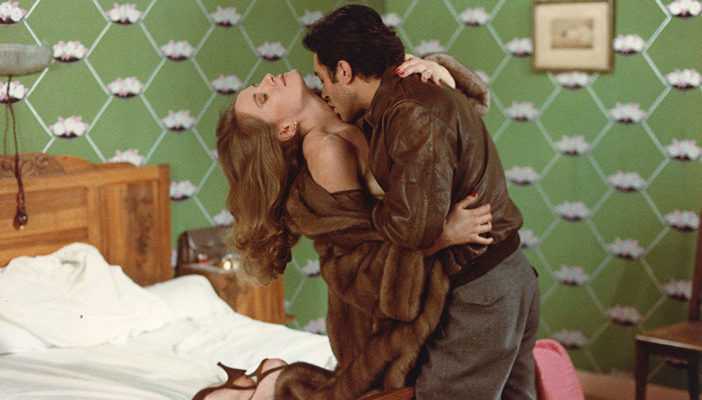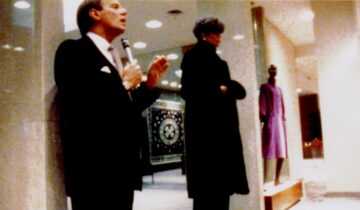So as not to bury the lede, let me begin by acknowledging that Une chambre en ville (1982) is a very strange film: made at the end of what was, by most counts, a lost decade for its writer-director, Jacques Demy, Une chambre en ville is a dark and deeply romantic all-singing musical operetta (like 1964’s The Umbrellas of Cherbourg) staged within the real historical context of the seven-week Nantes workers strike of 1955. There are lyrics–though no songs–about workers’ rights, spousal abuse, and unwanted pregnancies. Michel Piccoli’s (Contempt, Belle de Jour) sadistic and impotent television repairman, Edmond Leroyer, takes on the unsettling appearance of a leprechaun, while his new bride Edith (The Conformist’s Dominique Sanda) poses as a streetwalker, naked throughout much of the film beneath a flowing fur coat. All the while, easy listening and disco musical cues combine with more classical motifs to provide accompaniment for the film’s edgy dialogue.
And neither exactly because of nor in spite of all of the above, Une chambre en ville is also a major, even masterful work of cinema, and a fulfillment of the New Wave aesthetic and ethic that was making a strong return in the first years of the 1980s with Every Man for Himself, Passion, The Aviator’s Wife, A Good Marriage, Le Pont du Nord, Mon oncle d’Amérique, Sans Soleil, among others.
Une chambre en ville opens with its politics imposed over a hazy image of the city’s shipyards: Demy runs the entirety of the film’s credits, highlighting the labor of his many collaborators (and refusing the customary last credit for himself), before we transition to the black-and-white of the opposed police forces and protesters. The newsprint imagery is quickly replaced by the director’s pure colors as the police charge at the strikers, impelled by their insults. (Not much more will be said about the film’s Leftist, labor-strike subject, save to say that it is one of the film’s most distinctive and distinguishing aspects, beyond its operatic form.) Thus begins the film’s exceptionally compressed time structure where, over the course of a single night and the following day or two, a young couple meets and falls in love, two couples break up, a metal worker is laid off, two characters kill themselves, and the strike finally has fatal consequences for a third. In the midst of this grand tragic narrative, Edith consults with a fortune-teller who predicts her new love affair and more broadly, her fate.
Yet, in Demy’s hands, as one of the old hands of the ever self-reflexive nouvelle vague, that fate is more than what we think of as traditional fate, more than an explanation for an indifferent universe: as Edith is told by the psychic of the metal worker in her future (Richard Berry’s François Guilbaud), we come to see this revelation as a future incident in the film’s plot, of something that is going to happen in the story created by Demy. Our reason for this reading rests in the film’s pro-filmic relationship to the world. Demy’s authorship is always immediately clear and evident on the surface, in the pictorial image. As with his previous bold-hued masterpieces, The Umbrellas of Cherbourg and The Young Girls of Rochefort (1967), we are beholding a cinematic universe that always gives the impression of intent and design. Color, of course, is the biggest tell in this respect as Demy’s palette spreads from costume to set design, with matching tones and complementary colors (blues and oranges, violets and yellows, reds and greens) dominating the director’s mise-en-scène. The characters themselves are assigned colors to suggest romantic compatibility–as with the brown coats and later (in a portend of things to come) red shirts of Edith and François; or the violet worn by Violette and her wistful secret admirer Dambiel–or in other cases, their moral character (as with the sickly green suit worn by Piccoli, to match his sinister television repair business–sinister that is for a lover of cinema like Demy). The point is that artistic intention is directly manifest everywhere in Demy’s work, from the mechanics of the plot to the film’s saturated pure color.
There, of course, is more to say still about Demy’s use of color, beyond the individual choices of hues that express his narrative. The very fact of their conspicuousness, purity, and the combinations they form help to establish a different form of spectatorship in Une chambre en ville, one that helps us to unlearn the original sin of classical film art: the act of following stories to the neglect of their non-narrational visual qualities. Sure there is, as described above, no shortage of plot in Une chambre en ville, no lack of narrative of incidence to apprehend. Yet, in the moment to moment experience prescribed by Demy through his directorial choices, we read the film differently. We consider the colors for the associative and symbolic value, but we also scan the two-dimensional visual plane, looking for the various color combinations that organize the director’s visual space, as much visually as thematically. In this sense, the brief appearance of Henri Matisse’s Icarus (1947; from the “Jazz” series) is instructive, or at least the appearance of a Matisse is: like the artist’s Fauvist work in particular, color and especially complementary colors organize the visual space and direct our attention to various sections within the visual field, a de-centered space that by design renders figure and architecture equitably, as if belonging to the same basic (artistic) substance. Like Matisse before him, Demy is one of the great “decorative” artists, one who thinks his film in the totality of the visual field. To use another, historically less pejorative term, Demy’s cinema is Modernist, again in the early 20th century Matissean sense.
This same quality emerges in the filmmaker’s use of music, both in its studied combination of high and low vernaculars, and also in its song-less approach to musical form. Yes, every word is sung in operetta fashion in Une chambre en ville, and yes there are passages and styles that distinguish Demy’s musical forms. However, this is also a musical without any traditional songs, following his approach with The Umbrellas of Cherbourg. As a formal strategy, the sung dialogue again encourages a different form of narrative apprehension, one that doesn’t stop with its content. Trading on our assumptions about the musical genre, Demy’s lyrics become a catalog of banality and (using the term as lightly as possible) obscenity–though in other cases they also do express standard romantic sentiment. His characters sing about what other non-Modernist musical characters traditionally don’t, in a manner that fails to distinguish between conventional musical numbers and non-song passages, a division in the classical musical that helps to re-position the sung as something that exists in another ontological register (such as the emotional or spiritual) or outside everyday experience. In Une chambre en ville, as in The Umbrellas of Cherbourg before it, Demy shatters this distinction.
Where Une chambre en ville departs most from its predecessor is less in its formal conception, which is remarkably similar to the 1964 musical–down to its intertextual relationship with the director’s first film, Lola (1961), which was also set in the filmmaker’s hometown–than the elements of its execution and content. There is a good deal more of the vulgar in Une chambre en ville, compared once more to Umbrellas’ perfectly manicured, comparatively timeless art cinema. Une chambre en ville brings the whiff of exploitation with it (sex films, splatter horror, soap operas, and so on), making it an unmistakable object of its own early 80s moment, of an era distinguished by a revived approach to genre and an increasing distance from the many excesses of the 1970s. Yet it combines these elements (and the others mentioned in the opening preamble, including especially the film’s political framework), with the same basic form and look as The Umbrellas of Cherbourg, to create a work that further exposes and adds to the frictions that the earlier film’s Modernist form introduced to the musical.
Une chambre en ville in these senses extend and elaborate the filmmaker’s art, while maintaining every bit of the grand romantic sweep of his 1960s cinema. That he accomplishes the latter within the many peculiarities of the film’s form only adds to its significant achievement.
Une chambre en ville screens once, Thursday, July 27th at 7:30 pm, at the Samuel Roberts Noble Theater.










